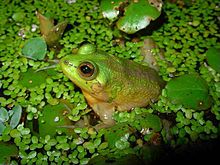Pseudis paradoxa
| Pseudis paradoxa | |
|---|---|

| |
| Scientific classification | |
| Domain: | Eukaryota |
| Kingdom: | Animalia |
| Phylum: | Chordata |
| Class: | Amphibia |
| Order: | Anura |
| Family: | Hylidae |
| Genus: | Pseudis |
| Species: | P. paradoxa
|
| Binomial name | |
| Pseudis paradoxa (Linnaeus, 1758)
| |
| Synonyms[2] | |
| |
The paradoxical swimming frog, paradox frog, jackie, jacky, proteus frog, swimming frog, or paradoxical frog (Pseudis paradoxa) is a frog that lives in Colombia, the Guianas, French Guiana, Guyana, Suriname, Bolivia, Trinidad, and Peru.[2][3]
Most adult frogs are 45 to 65 mm long from nose to rear end, but some of them can be more than 75 mm long.
The skin on the frog's back is green toward the head and front. It is brown toward the rear end. It can have three or four brown lines. The frog's belly is white.[3]
This frog eats insects and smaller frogs.[3]
This frog mates after rain or other wet weather. The male frogs hide next to plants near the top of the water and sing for females. The females lay eggs that look like green froth on the top of the water.[3]
If the mother frog lays eggs in a temporary body of water (the kind that dries up), the tadpoles turn into frogs quickly. If the mother frog lays eggs in a permanent body of water, the tadpoles stay tadpoles for a long time. These tadpoles grow to huge sizes.[3]
The tadpoles of this frog can grow to be 22.0 cm long, much larger than the adult frogs. This is one of the largest tadpoles of any frog in the world.[3] It is smaller when it is an adult than when it is a tadpole.
The name "paradox" here means "riddle" or "something backwards." For this frog, it means that the tadpole is larger than the adult.
References[change | change source]
- ↑ Ariadne Angulo; Diego Baldo (2010). "Swimming Frog: Pseudis paradoxa". IUCN Red List of Threatened Species. Version 3.1. International Union for Conservation of Nature. Retrieved January 21, 2022.
- ↑ 2.0 2.1 "Pseudis paradoxa (Linnaeus, 1758)". Amphibian Species of the World 6.0, an Online Reference. American Museum of Natural History. Retrieved January 21, 2022.
- ↑ 3.0 3.1 3.2 3.3 3.4 3.5 Rachna Tiwari; Tate Tunstall (January 18, 2002). Tate Tunstall (ed.). "Pseudis paradoxa: Paradox Frog, Paradoxical Frog". Amphibiaweb. University of California, Berkeley. Retrieved January 21, 2022.

